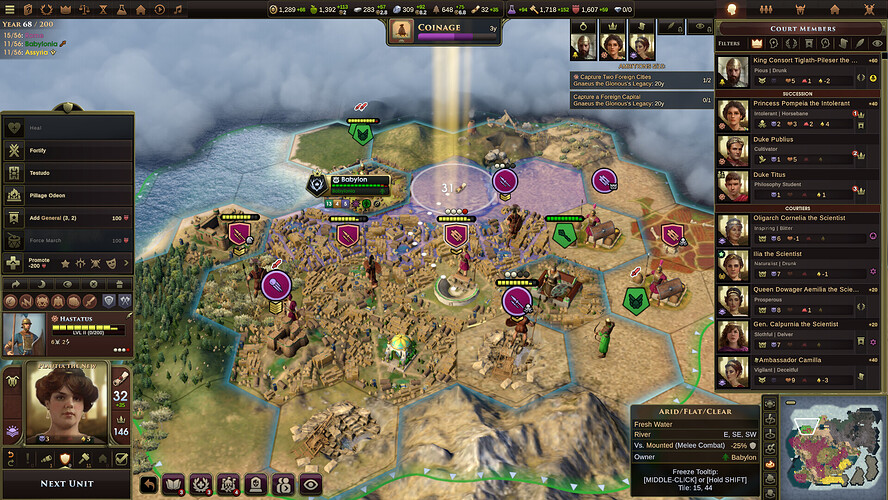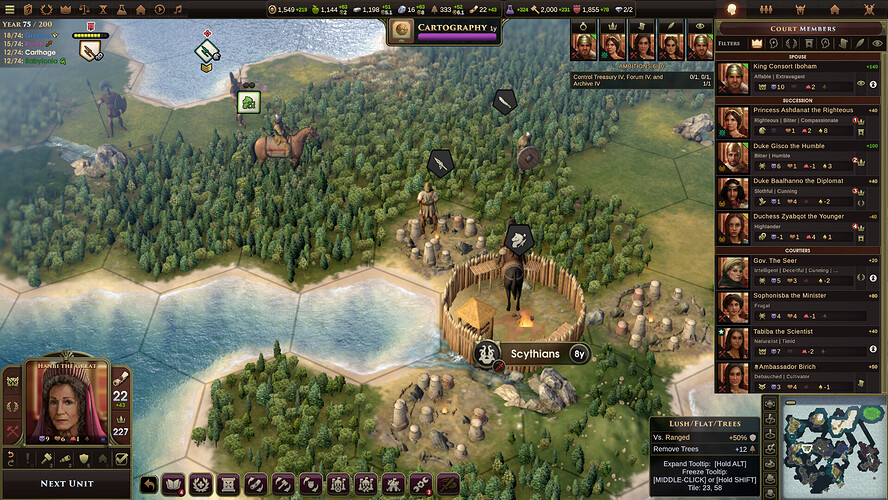You don’t actually steal their production when you get their people, do you? I figured since your in-game court is tiny relative to a real king’s, they’re just not showing you the people who won’t spend their life working for you, and then they simulate that by not hurting the AI when giving you the bonus.
I don’t mean to imply I think the opponents lose 5 beakers and 16 coins when I gain their daughter. I just mean that I never lose a character, but I can add them. It’s a very minor part of the gameplay, but feels self-centered.
If you really want to lose characters, just throw them in jail. Pretend your victim married some Scythian princess and the 500 coin you seized when you sold his estate is a dowry.
-Tom
There are events where you are asked to send your kids/royal away for royal marriages but they aren’t very common.
I appreciate your responses here, Soren. Do you wish to expand on any of these other questions? I’m not sure if you declined to answer or missed them.
-
Who do I have authority to marry? I thought it was any unmarried successor 18-years-old. Is it just my heir (successor #1)? Does it depends on their relationship to the leader, i.e., you can order your kids to get married but not cousins or in-laws?
-
Is there a way to modulate the religion a family chooses to have? A character?
-
You revealed that rushbuy costs increase by 10% each time. Is that true when the rushbuys occur using different resources/methods? You also revealed earlier civic hammers are more expensive than later hammers. How do I anticipate how many Orders it’ll cost to rush buy a 160 shield unit, if I have previously used a Judge to rushbuy 3 specialists for 1,000 coins? Is there a formula I could put into a spreadsheet?
-
A tool tip names 3 archetypes that are more common in each family’s characters. How much more common? What are the probabilities of, say, Judges coming from Statesmen? Diplomats from Hunters?
-
Are the spawning traits of characters completely random? I get a lot of Bitter characters and ?never? a Cunning one.
-
Do families have tendency in the ambitions they offer? I used to think so, but have enough foreign invasions from Sages and Artisans. My Champions are equally keen for world peace as domestic production.
- You can only marry off your direct descendants.
- The more characters that follow a religion, the more likely the family is to follow it. (The family head counts more as well.)
- The cost only goes up per type (so rushing with money doesn’t affect rushing with order)
- Um… more likely? I would guess at least half will be of the preferred archetype.
- Pretty random. You should get cunning ones eventually.
- Yes, families definitely prefer certain types of ambitions (but these ambition might not be eligible for various reasons at various times).
I am not understanding zones of control.
If my Hastasus can move across the river in the next image, it’s because the river is disabling the Acadian Archer’s (in Babylon’s home hex) zone of control.
Why does my Spearman require two orders to make the same move?
I assume this has something to do with Hastasus’s ignoring ZOCs?
What?! Rome is too easy. Zerg surrounds.
I’m trying to decide whether to play the Game of the Week or find out if Carthage has anything going for it. Is the difficulty choice indicative of the overall scenario’s challenge? I figure the scenarios are either designed to provide a potpourri for all players, or to be challenging even when the AI is set to peaceful.
Does anyone have an idea in what order a player’s turn is processed? For instance, I was surprised that my diplomat leader finished a national alliance on the turn she died, but the ambition we completed that same turn occured after my leader died (+5 legitimacy). From change notes I’m aware that if the tutor is alive when you end turn with 1 turn left on the tutor mission, it will complete. I’m glad diplomatic missions are consistent. But, it would appear that tile improvements with 1 turn left do not complete before your leader dies (my ambition was for 6 urban tiles). I would hope that capturing enemy cities complete before a leader dies, but I’m not sure.
This creates a situation where, if your ambition was to make peace with every nation and tribe, and a diplomatic peace mission had 1 turn left while your leader is Doomed, you could achieve the ambition while the leader lives (+10 legitimacy). But if your ambition is to build X urban tiles, if your leader is Doomed when the last tile is 1 turn away, you will complete the ambition after the leader dies (+5 legitimacy).
We prefer to be generous with this, so I will check on the urban tile question.
What controls the ascension of tribal units and fortifications? I’ve observed the turn timer to “Next Unit” or “Next Upgrade” to bastion or somesuch. But the turn timers seem to vary across tribal city sites?
In this game, the first Scythians I visited had Amazonian Horse Archers (Strength 5, Mounted, Range 2, Move 3) and no other unit types. That’s three city sites with 4 Amazonian Horse Archers around each.
One of those units became my mercenary. His horse was startled to see that in conquests ten turns later, his brothers were in short supply. In this image, the Sycthians are Skirmishers and Elite Skirmishers (Strength 4).
For other people learning the game:
I learned the recruitment cost of a tribal unit increases with negative reputation. I had recently completed an ambition to bank 10,000 gold, so I planned to buy all the Horse Archers I could, and use them immediately* to fire on the city site to kill the unrecruitable one stationed in the city center. This only works once, in my experience. The first 3 archers cost ~600 gold each. Each subsequent horse had cost ~50 gold incrementally more. I used those to take the first city site, and the reputation hit of that conquering put Scythia at -190 reputation. Now, the next round of archers started around ~950 gold each. After taking the next city tile, the cost are ~1,400 gold each, which is too rich unless it was an emergency defense situation.
*after the 1 turn recruit cooldown
Each Tribal Settlement costs +10 more turns to develop than the last one, plus a 1d10.
Are you saying each phase of fortification costs +10 + X more turns than the last on that same city site? Meaning on the edge case, a tribal city site could go through all 3(?) phases of development in 33 turns, another in 60 turns, and the median takes 45? But, tribes aren’t fully fortified at turn 60, so there must be something else going on.
Is it the case that each tribal city site wants to generate 4 units, and only after that quota has been reached, begins improving the fortification? That seems like what I’ve observed, but doesn’t explain how unexplored tribal sites replace old Skirmishers with new units.
Unrelated, what are the fortification bonuses. +25, +50, +75%? Does the level of “improvement” determine what units can be produced?
Is there a way to check what kind of defense projects a foreign city has before attacking? There’s no health meter to hover over.
Level 2 upgrade is 20-30 turn, Level 3 is 30-40, and Level 4 is 40-50. So, the range to the highest level is 90 to 120.
Aren’t there visual cues on the map? Like, you can literally see the defenses they’ve built? I’m pretty sure the defense projects create specific graphics on the tile when they’re built, but I would also be surprised if the defenses weren’t listed somewhere in the info box for the city. At the very least, they should show up in the calculations before committing to an attack.
-Tom
I’ve seen moats. They make a mess of the already lengthy task of understanding which tiles have rivers between them. I don’t know what walls or towers look like.
You gave me the idea to declare war, forecast an attack, and then use undo.
I wonder if the folks at Mohawk knew how much the undo button helps as a learning tool. Because before Old World, I had no idea that I wanted an undo in pretty much every game as I’m learning it.
-Tom


